Xing Shu (行书) stílus - a "félkurzív" stílus
Xing Style is a style in between cao and kai styles. It was established by Liu Dengsheng (劉德昇) in the Han Dynasty. He depressed the wave in zhang cao (章草), simplified and reduced the wave (雁尾, yan wei) in han li (漢隸). Thus xing style could be written faster than li and kai styles.
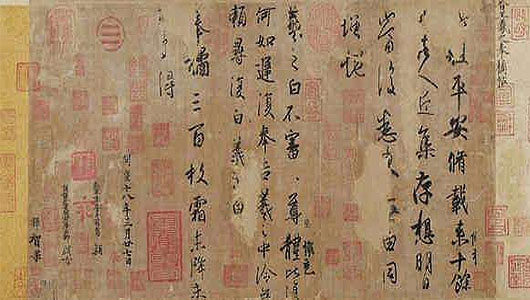
Liu Dengsheng's (劉德昇) work in xingshu
Xing style can also be freely expressed without a fixed boundary. If it’s close to cao style, it’s called xing cao shu (行草書). If it’s closed to kai style, it’s called xing kai shu (行楷書). For example, many of Zhong Yao's (鍾繇, 151-230) works were in between xing and kai stles mixed with a few cao style characters.
The most famous calligraphy work in xing shu is Wang Xizhi’s (王羲之, 303–361) Lan Ting Prologue (The Preface to the Orchid Pavilion Collection, 《蘭亭集序》, also commonly known as Lanting Xu) written in 353, Emperor Tang Taizong (唐太宗) was deeply obsessed by this work and it was buried with him at Zhao Ling. Many duplicate copies of this work thus became one of the most important examples to study Wang Xizhi’s calligraphy for centuries. Because of Tang Taizong’s favor of Wang Xizhi’s calligraphy, Chinese calligraphy was deeply influenced by Wang Xizhi and his son Wang Xuanzhi since the Tang Dynasty.
Due to the modern technology of duplicating and printing, many of Wang Xizhi’s works are conveniently displayed for public appreciation in museums or for private collection at affordable prices. One of his most famous works is displayed in the National Museum of Palace in Taipei, Taiwan.
Features of xing shu
A calligraphy work in xing style will look more smooth, connecting and faster than Kai Style, but less than cao Style. This is why xing shu is known as walking style and cao shu as running style. Xing shu usually simplifies the strokes and changes the sequences of strokes from kai shu writing. Sometimes a xing shu calligrapher will mix some cao shu or kai shu with xing shu.
The following two works of the Buddhist "Heart Sutra (心經)" were done in kai shu and xing shu:
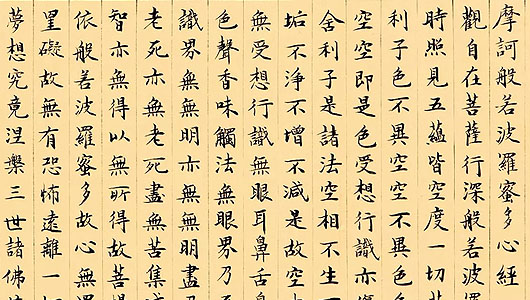
Heart Sutra (心經) in kai shu
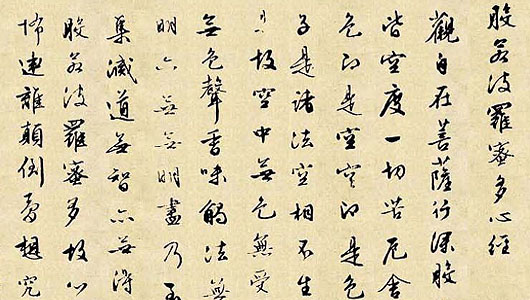
Heart Sutra (心經) in xing shu
Guide to Start xing shu
The compilation of Wang Xizhi’s xing shu characters into 怀仁集王羲之《大唐三藏圣教序》 by Huairen (怀仁) Buddhist Master in the Tang Dynasty has been an excellent and popular source for beginners to understand how each character is written in xing shu.
PREFACE TO SACRED TEACHING - 大唐太宗文皇帝製三藏聖教序 (Ink rubbing, Tang, 3rd year of the Xianheng reign (672) Jin Rubbing, 12th-13th century, Ink on paper, album of 54 leaves, each leaf 23.5 x 12.2 cm)
This engraving of Preface to Sacred Teaching is composed of characters meticulously assembled by the Buddhist monk Huairen (active 7th century) from different scripts originally written by Wang Xizhi and carved by Zhu Jingcang. The original stone, with 30 lines of 85 or 86 words each, is kept at the Forest of Stelae in Xian, Shaanxi province.
Preface to Sacred Teaching was written by Emperor Taizhong of the Tang dynasty (627-649) to mark the arrival of a volume of Buddhist sutras brought back and translated by Monk Xuanzhang (玄奘, 602 – 664). Li Zhi, the Crown Prince, wrote notes to commemorate the project. The writings of both father and son, including later appended letters, were immediately perceived as a symbol of authority in the canon of Buddhist scriptures. Therefore, the imperial texts were widely copied by Tang calligraphers and also transcribed onto stelae. Huairen of the Hongfu Temple in Chang'an produced an innovative alternative. Based on Wang Xizhi's original writing in running-cursive script, kept in the Imperial Library, he spent twenty-five years, from the 22nd year of the Zhenguan reign of Emperor Taizong (648) to the 3rd year of the Xianheng reign of Emperor Gaozong (672), compiling the blueprint of the stele text for engraving. Not only did this stele exert great influence on contemporary scholars and calligraphers, it also preserved the essence of Wang's calligraphy, leaving scholars of today a significant source for research. Due to frequent rubbing the engraving gradually faded, and the stele finally broke into two pieces in Song times. Formerly in the Yuexue Lou collection in Nanhai, Guangdong, this album is rubbed from the intact stele, with few of the characters damaged. It is appended with colophons from the Ming dynasty onwards. Judging from the perfect condition of the individual characters, this rubbing dates back to the Southern Song (Jin) period.
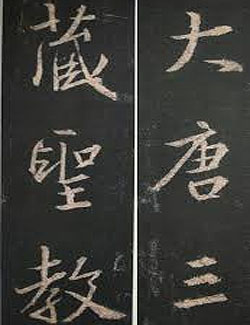
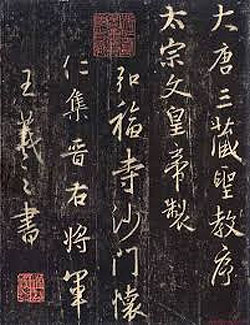
怀仁集王羲之《大唐三藏圣教序》
The compilation was done by cutting and pasting Wang’s characters into an article "San Zang Sheng Jiao shu (三藏聖教序)" written by Tang Taizhong in a preface concerning Xuan Zang's (玄奘 596-664) translations of Buddhist sutras from the Tripitaka (三藏). Since this model book is a compilation and Wang Xizhi did not write this work, inevitably there are some artistic inconsistencies. Wang’s Lan Ting Prologue and many calligraphers’ xing shu works are also suitable for beginners.
Only after the student has learned Kai shu well enough may she or he proceed to xing shu. A baby first learns to crawl and sit, then to walk and run. The stages cannot be reversed as in Chinese calligraphy – first kai style, then xing and cao styles. If the student still has difficulty in doing the smooth or faster strokes in xing shu, s/he needs to go back to practice kai shu more. A solid foundation leads to success in all arts while a radical progress may result in disappointment or failure.
Masters and works of xing shu
Liu Dengsheng (劉德昇, 146-189) [wikipedia]
He was famous for the establishment (not creation) of xing shu. He taught Zhong Yao and Hu Zhao.
Zhong Yao (鍾繇, 151-230) [wikipedia]
He studied calligraphy from Liu Deengsheng (劉德昇). People viewed his calligraphy as "swan traveling in the sky, wild goose playing in the sea". He was peered with Zhang Zhi and referred to as "Zhong Zhang (鍾張)". He was also peered with Wang Xizhi and referred to as "Zhong Wang (鍾王)". Emperor Liang Wu Di said there were twelve sets of mind levels with extraordinary wonders within his work.
Wang Xizhi (王羲之, 303-361) [wikipedia]
He earned the titles of "The Calligrapher-Sage (書聖)" & "The Dragon of Xing Shu (行書之龍)".
Lan Ting Prologue 《蘭亭集序》
March 3rd in the ninth year (353) of Yong He (an emperor of the Jin Dynasty), Wang Xizhi, Xie An and others met at Shan Yin (shao xing) Lan Ting. This was a poem meeting (similar to academic conference today). All people would write a peom there and they would make a collection of poems. Wang Xizhi wrote the preface for the poems collection. It's named Lan Ting Prologue. Lan Ting Prologue is highly valued by all calligraphers later. Tang Taizong (an emperor of Tang Dynasty) loved it very much. He ordered calligraphers to copy it and give to his officers. As his will, the original Lan Ting Prologue was buried with him. Since then, the only copies existing are the copies of the Tang Dynasty.
Wang Xianzhi (王獻之, 344-386) [wikipedia]
The 7th son of Wang Xizhi. He studied his father's calligraphy earlier and studied Zhang Zhi's calligraphy later, then he reformed bravely from his father's styles. His style was brilliant and heroic.
Yan Zhenqing (顏真卿, 709-785) [wikipedia]
He studied Chu Suiliang's (褚遂良, 596-658) calligraphy earlier. Later, he became a student of Zhang Xu (張旭, 675-750). He abandoned the existing rules of the earlier Tang Dynasty and created a brand new style of kai shu. His calligraphy theory and foundation were based on his teacher Zhang Xu’s teaching.
In the Tang Dynasty, both Xu Hao (徐浩) and Yan Zhenqing inherited Wang Xizhi’s calligraphy. Critics said Hsu Hao got his "skin and hair" in appearance so his work looked like Wang’s; however, Yan Zhenqing inherited Wang’s internal substance so his work did not look like Wang’s. His xing shu is highly regarded after Wang Xizhi’s.
Yan Master was also a high official in the army and a stateman. When viewing his work, one can feel the artist pouring the energy of his whole body, mind, and spirit into his writing, which is full of "virile beauty" and indications of his strong character and high moral standard.
Cai Xiang (蔡襄, 1012-1067) [wikipedia]
His achievement in xing style was considered higher than in kai style.
Mi Fu (米芾, 1051-1107) [wikipedia]
He was widely considered the best calligrapher in the Song Dynasty. Famous for his lifting arm (懸肘 = xuan zhou) skill while holding a brush to generate unique flowing and connecting effects in his xing and cao styles. He was very good at emulating ancient masterpieces – he could duplicate the Two Wang’s works so well that the viewers could not tell the difference.
《宋史文苑傳》說:“芾特妙于翰墨,沈著飛,得王獻之筆意。”《宣和書譜》 說他:“大抵書效羲之,詩追李白,篆宗史籀,隸法師宜官;自謂‘善書者只有一筆,我獨有四面’,識者然之。方芾書時,其寸紙數字人爭售之,以為珍玩。”
他在繼承“二王”書法傳統上下過苦功,能夠登堂入室。真、草、隸、篆、行都能寫,而尤以行草書見長。他自稱“刷字”,是指他用筆迅疾而勁健,盡興盡勢盡力,追求“刷”的韻味、氣魄、力量,追求自然。他的書法作品,大至詩帖,小至尺牘、題跋都具有痛快淋漓,欹縱變幻,雄健清新的特點,快刀利劍的氣勢。
Gao Zong of Song (宋高宗, 1107-1187) [wikipedia]
When he was the Emperor, he practiced calligraphy every day for fifty years. He gave up learning Huang Tingjian’s and Mi Fu’s calligraphy and focused mainly on the Two Wangs. He emulated Wang Xizhi’s xing shu pretty well.
Xian Yusu (鮮于樞, 1257-1302) [wikipedia]
He studied Zhang Tiensi’s work first, then Jin & Tang Dynasties’ calligraphy to establish his style. He inherited the Two Wangs’ spirit. He and Zhao Mengfu deeply admired each other.
Zhao Mengfu (趙孟頫, 1254-1322) [wikipedia]
He was good at various styles. He was a descendant of Song Dynasty royal family. He and Xian Yusu (鮮于樞) deeply respected and admired each other's achievement.
Dong Qichang (董其昌, 1555-1636) [wikipedia]
He studied works by Yan Zhenqing (顏真卿), Yu shunan, Huang Tingjian. He despised Wen Zhengming and Zhu Yuenming. He was also a famous painter. He was the favored Chinese calligrapher by the emperors in the Ming Dynasty.
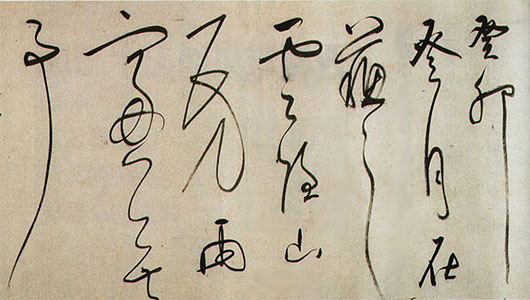
Dong Qichang's (董其昌) work
Pu Xinru (溥心畬, 1896-1963) [wikipedia]
Good at literature, poetry, calligraphy and painting. His kai shu was considered number one in the last 500 years of history by many scholars. Member of late Qing royal family.
Connecting Effects - the Xing Qi (行氣)
在行草書中行氣平衡有時不可以單字論平衡,必須以起筆到收筆中每字論總平衡。 每一字的重心,隨著運筆動線流動,每一行運筆動線又繞著中心線走,因此字或偏左,或偏右。
xing qi (行氣) - Flow of Qi in a line or between the lines. Xing qi (行氣) is the connecting effects between several characters in a line (行) or several lines. When Chinese say a good calligraphy work has good (行氣), we may also refer to the spiritual consonance of the work viewed as a whole. Qi (氣) refers to the consistent and uninterrupted energy flow. A work with good (行氣) appears to consist of strokes being joined to the next ones by visible and invisible ligaments or you si (游絲) and artistic arrangements of spacing between the strokes, characters, and lines with expressions and rhythms. When a Chinese calligraphy work of any style lacks of xing qi (行氣), it will look choppy. The elements of xing qi (行氣) may include consistent, artistic, and continuous flow of energy and beauty. They are especially important for xing and cao styles.
Xing qi (行氣) is not only important in practicing xing and xao Styles; it’s important for all five major styles. Good xing qi (行氣) depends on training, skills, mental design, confidence, and etc. It can be obtained by correct postures and be improved indefinitely.
In practicing Chinese calligraphy with good xing qi (行氣), one cannot be interrupted during writing. Any mental or physical distraction will decrease the artistic level in terms of xing qi (行氣). Thus it’s advisable to finish a work without a break or any interruption unless it’s extremely long (say 100 or 200 characters). It's also not advisable to start writing Chinese calligrahy characters "from left to right" as this may compromise the artistic spirit and twist xing qi. Observing and copying (including repeatedly trying) ancient Chinese calligraphy models are good ways to cultivate good xing qi (行氣). The Hanging Arm Technique is strongly recommended for uninterrupted connecting effects.
Summary of Learning
A good foundation in kai shu leads to success in xing shu and cao shu. Without a strong foundation in kai style, there is no guaranteed success to try learnining the semi-cursive and cursive styles. Chinese calligraphers often make the following analogies and assert that the stages cannot be reversed for beginners. After getting better with kai shu, some calligraphers suggest to practice kai shu (also called zhen shu 真書) and xing shu interchangeably ("Zhen Xing Xiang Jian 真行相兼") In this way, we may strengthen our foundation in kai shu to make progress in xing shu while raising our Kai shu level and make it look more flowing and smooth by benefiting from practicing xing shu.

